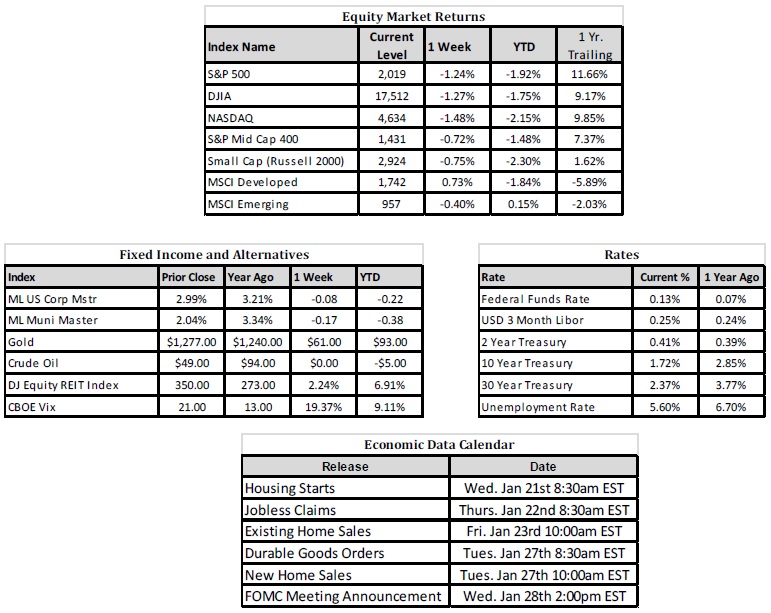
Capital Markets Update – Week of 1/19/2015
Market Overview
Sources: Rates Data and Economic Calendar—Bloomberg Markets as of 1/20/15; Equity Market Returns and Fixed Income and Alternatives Data—Wells Fargo Advisers as of 1/16/15.
Happening Now
Event Fueled Trading Continues in 2015
European equity markets opened the week on a positive note Monday gaining 1.3% in the UK (FTSE 100), 4.7% in Germany (DAX) and 3.9% in France (CAC). Overall, the MSCI Europe index gained 2.34% when measured in US Dollars1. This positive trend has spilled over into Tuesday with early gains in each of the above indexes continuing. These gains come ahead of the ECB’s meeting on Thursday when it is widely anticipated that Bank Head Mario Draghi will announce the commencement of sovereign debt purchases, the latest step in what otherwise has been a less than expected quantitative easing program2.
Markets were closed in the U.S. on Monday for observance of Martin Luther King Day, and will have a batch of economic news to digest when they open Tuesday. China’s GDP expanded 7.4% in 2014 beating expectations slightly. The International Monetary Fund lowered global GDP expectations for 2015 by 30bps from 3.8% to 3.5% while increasing the U.S. GDP forecast from 3.1% to 3.6%3. It should also be noted that the 2015 Real GDP Consensus Forecast for the U.S. according to Consensus Economics is 3.0%. This should be an eventful week for traders that are still catching their breath after the spike in volatility last week that came as a result of the Swiss central bank removing their currency’s peg to the Euro.
We still contend that the U.S. is the most attractively positioned country from both an economic standpoint and in terms of the growth potential in their equity markets. Maintaining this position, of course, depends on U.S. corporations continuing to expand revenue and increase earnings. We will be paying close attention to the earnings announcements coming out this week with the understanding that future growth should take the form of not only multiple expansion but true bottom line growth.
With the many moving parts described above, we strongly suggest investors review their asset allocation strategies to determine how they may have shifted. There has been significant capital appreciation in both stock and bond markets since 2009 and any investors that have taken a “hands-off approach” to rebalancing may be surprised to see how their allocations have changed.
- http://news.morningstar.com/index/indexReturn.html
- http://www.bloomberg.com/news/2015-01-18/euro-is-near-11-year-low-before-ecb-franc-holds-historic-rally.html
- http://www.reuters.com/article/2015/01/20/us-markets-oil-idUSKBN0KT02Y20150120
Important Information and Disclaimers
Past Performance is not a guarantee of future performance.
Investing in foreign securities presents certain risks not associated with domestic investments, such as currency fluctuation, political and economic instability, and different accounting standards. This may result in greater share price volatility. These risks are heightened in emerging markets.
There are special risks associated with an investment in real estate, including credit risk, interest rate fluctuations and the impact of varied economic conditions. Distributions from REIT investments are taxed at the owner’s tax bracket.
The prices of small company and mid cap stocks are generally more volatile than large company stocks. They often involve higher risks because smaller companies may lack the management expertise, financial resources, product diversification and competitive strengths to endure adverse economic conditions.
Investing in commodities is not suitable for all investors. Exposure to the commodities markets may subject an investment to greater share price volatility than an investment in traditional equity or debt securities. Investments in commodities may be affected by changes in overall market movements, commodity index volatility, changes in interest rates or factors affecting a particular industry or commodity.
Products that invest in commodities may employ more complex strategies which may expose investors to additional risks.
Investing in fixed income securities involves certain risks such as market risk if sold prior to maturity and credit risk especially if investing in high yield bonds, which have lower ratings and are subject to greater volatility. All fixed income investments may be worth less than original cost upon redemption or maturity. Bond Prices fluctuate inversely to changes in interest rates. Therefore, a general rise in interest rates can result in the decline of the value of your investment.
Definitions
MSCI- EAFE: The Morgan Stanley Capital International Europe, Australasia and Far East Index, a free float-adjusted market capitalization index that is designed to measure developed-market equity performance, excluding the United States and Canada.
MSCI-Emerging Markets: The Morgan Stanley Capital International Emerging Market Index, is a free float-adjusted market capitalization index that is designed to measure the performance of global emerging markets of about 25 emerging economies.
Russell 3000: The Russell 3000 measures the performance of the 3000 largest US companies based on total market capitalization and represents about 98% of the investible US Equity market.
ML BOFA US Corp Mstr [Merill Lynch US Corporate Master]: The Merrill Lynch Corporate Master Market Index is a statistical composite tracking the performance of the entire US corporate bond market over time.
ML Muni Master [Merill Lynch US Corporate Master]: The Merrill Lynch Municipal Bond Master Index is a broad measure of the municipal fixed income market.
Investors cannot directly purchase any index.
LIBOR, London Interbank Offered Rate, is the rate of interest at which banks offer to lend money to one another in the wholesale money markets in London.
The Dow Jones Industrial Average is an unweighted index of 30 “blue-chip” industrial U.S. stocks.
The S&P Midcap 400 Index is a capitalization-weighted index measuring the performance of the mid-range sector of the U.S. stock market, and represents approximately 7% of the total market value of U.S. equities. Companies in the Index fall between S&P 500 Index and the S&P SmallCap 600 Index in size: between $1-4 billion.
DJ Equity REIT Index represents all publicly traded real estate investment trusts in the Dow Jones U.S. stock universe classified as Equity REITs according to the S&P Dow Jones Indices REIT Industry Classification Hierarchy. These companies are REITSs that primarily own and operate income-producing real estate.




